The Freshwater Fisheries Society of BC kicked off its pilot Native Trout Stewardship Initiative with the funding of seven trout conservation-focussed projects in 2019. The purpose of this initiative is to support local stewardship groups seeking to protect, conserve, and recover native trout species in B.C. watersheds. The focus is in urban and developed areas, and primarily on coastal cutthroat trout – a fish highly prized by anglers, but frequently forgotten because they aren’t as big or as numerous as salmon. However, where funding permits, other projects will be considered.
In this first article, we look at three of the seven projects the Initiative funded in 2019.
Project Profile – Chenatha Watershed Restoration
The Chenatha River is a small coastal stream located close to Ucluelet on Vancouver Island. Its watershed has been heavily logged since the 1970s, resulting in significant degradation of fish habitat.
The Central Westcoast Forest Society (CWFS) has been working with the Toquaht Nation since 2013 to restore habitat within this watershed. They have hopes of rebuilding searun and resident salmonid populations including coho, chum, and pink salmon, as well as steelhead, coastal cutthroat trout, and rainbow trout – all historically reported to be present here.
A restoration boost for a small west coast stream
In 2019, the Society contributed funds towards this multi-partner initiative for what might be the final year of restoration to complete the project. The work includes incorporating new, large woody-debris structures to create cover and habitat complexing, and replanting banks with native plants to address bank erosion. For resident salmonids like coastal cutthroat trout that use a freshwater environment for extended periods, having intact stream habitat year ’round is critical.
Partners include: Toquaht Nation, Fanny Bay Salmonid Enhancement Society, and Thornton Creek Salmonid Enhancement Society
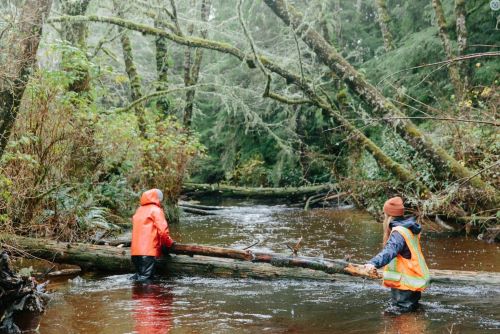
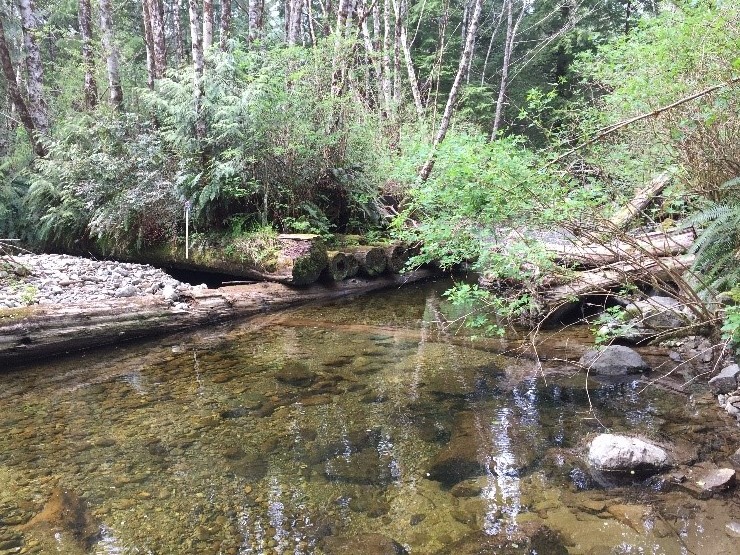
Project Profile – Little River Fish Habitat Restoration
The Little River Enhancement Society (LRES) has been active on Beaver Meadow Farms in Comox since the early 1980s. The Little River is a small coastal stream that supports native coho and chum as well as trout. Fed by a spring that keeps the river’s waters cool year ’round, the stream has the potential to be highly productive. However, poor land practices in the past have resulted in degradation of spawning habitat and negative impacts to water quality.
In the past five years LRES has used funding from numerous sources to restore the habitat in the Little River, and is in the final phase of restoration in the river. Since starting their restoration projects, they have seen a major increase in the number and size of the salmonid species leaving for the ocean every year.
A sweet little coastal cutthroat trout stream in Comox Valley gets some extra attention.
Until this year, the LRES has focussed on salmon enhancement and habitat restoration. Habitat restoration has taken place in all sections of the river and creeks in the watershed where key spawning and rearing habitats exist. During this work, trout were repeatedly observed. Now, with funds from the Society, the LRES is able to focus their efforts on better understanding the cutthroat trout population in the Little River, and identifying key habitats that could benefit from restoration actions.
Already this spring, the group counted more than 200 cutthroat juveniles headed downstream, undoubtedly to spend the summer feeding and growing in nearby marine waters. With this impressive count for a small stream, clearly this system has the potential to support a robust population of cutties. While climate change impacts stream flows up and down Vancouver Island during the summer, spring-fed streams like the Little River are critical refuges for cool-water species like coastal cutthroat, and warrant efforts to protect and restore key habitats.
Partners include: Beaver Meadow Farms, Pacific Salmon Foundation, supporters and land owners along the Little River.
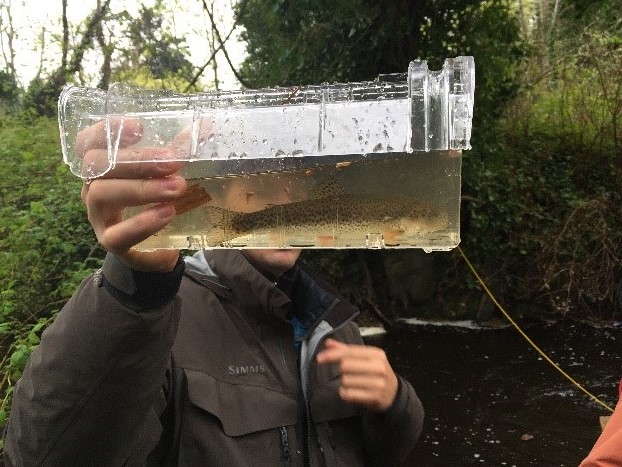
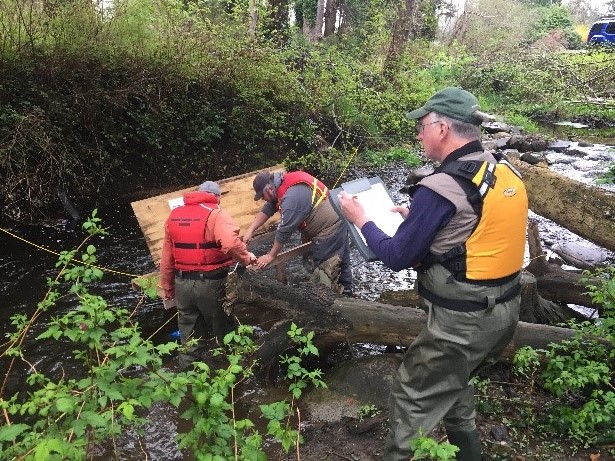
Project Profile – Portage Inlet Cutthroat Initiative
It’s exciting to see coastal cutthroat trout take the spotlight for an urban-watershed initiative in the Greater Victoria region. At one time, well known to local anglers, Portage Inlet supported an abundant run of searun cutties.
Unfortunately, decades of urban development have taken their toll on both the inlet and tributary streams. Creeks like Colquitz and Craigflower are where cutthroat trout migrate to spawn as adults and rear as juveniles. In fact, the Colquitz River was once the most important trout stream in the area. Cutthroat are still present, and some anglers are still lucky enough to attract one in the saltchuck, but their numbers are significantly reduced to a mere fraction of what they once were.
An impressive collaboration to see a frequently forgotten fish rebound in its natural habitat.
Today, a coalition of local stewardship, angler, and other groups have banded together to protect this species, learn more about its needs in the watershed, restore key habitats, and hopefully see numbers improve. Led by the World Fisheries Trust, and supported in part by funds from the Society as well as several other groups, not to mention the significant hours and contributions from volunteers, this multi-pronged initiative is committed to undertaking several key activities that target coastal cutthroat trout. They are also collaborating with a broader coalition of local groups for salmonid stewardship work in the area.
Some key activities the group is doing for cutthroat include:
- Mapping of freshwater and inlet habitats
- Water flow and assessment to determine fish needs
- Fish and habitat assessments
- Barrier and garbage removal on Colquitz to allow fish to migrate and access important habitats
- Fish habitat restoration at key locations
- Invasive plant removal in riparian areas
- Outreach at public workshops to spread the word.
Partners and contributors include: World Fisheries Trust, Peninsula Streams Society, Victoria Golden Rods and Reels, Esquimalt Anglers Association, Haig-Brown Fly Fishers Association, Victoria Fish & Game, Sidney Anglers, Hemmera (an Ausenco Company), Pacific Salmon Foundation, Loblaw Water Fund (WWF)
You can find more information on the project on the World Fisheries Trust website.
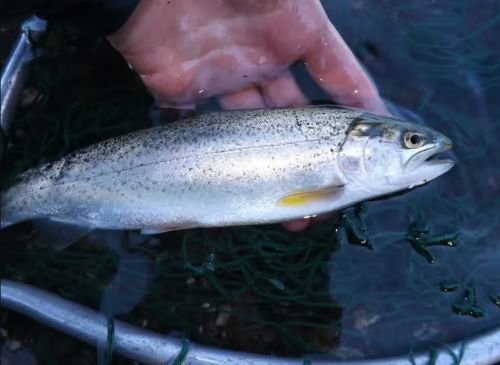
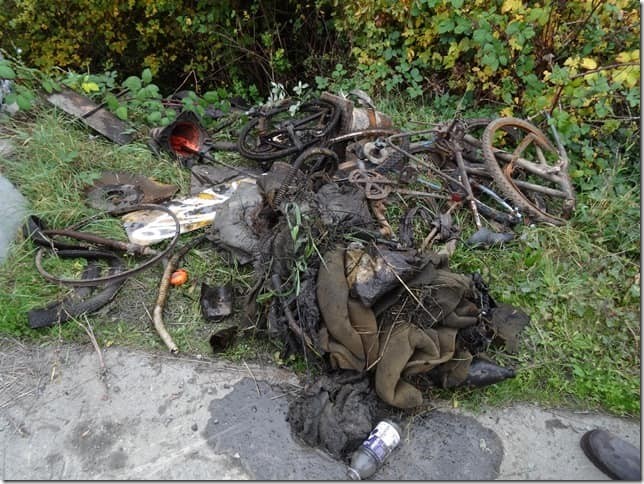
Author: Sue Pollard, Freshwater Fisheries Society of BC